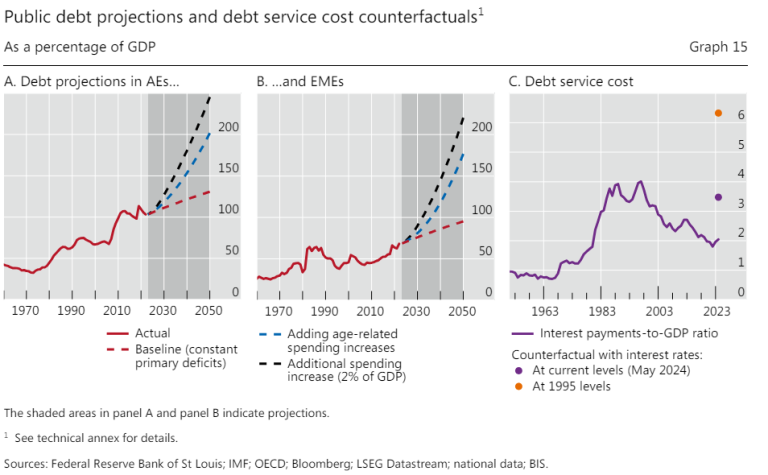- Forceful central bank action to stem inflation has the global economy poised for a smooth landing, although some pressure points could still throw it off course.
- To lay solid foundations for the future, central banks must finish guiding the economy back to price stability and governments must act on public finances and overdue reforms.
- BIS analysis describes lessons learned for central banks since the turn of this century and the implications for monetary policy frameworks in the future.
The global economy is poised for a smooth landing, but risks remain and policymakers must take a long-term view to lay the foundations for sustainable growth, the Bank for International Settlements said in its annual report.
On refinancing, the report noted that: “If interest rates remain at current levels, as governments refinance maturing bonds, the debt service burden will rise close to the record levels of the 1980s and 1990s. Should rates climb further, say, reaching the levels prevailing in the mid-1990s, debt service burdens would soar to new historical peaks, above 6% of GDP.”
Speaking at a media briefing, Agustin Carstens, BIS general manager, said that refinancing at a higher rate of interest can introduce stresses in households, corporations, and governments.
“Refinancing at higher rates, we haven’t seen it through the whole cycle and therefore what we are advocating for is to just be patient about that, and not declare victory too early,” he said. “This doesn’t call for an adjustment of monetary policy…we need to watchful for not declaring success early from the point of view of a soft landing, not only in economic activity but also in financial stability.”

Analysis in the BIS Annual Economic Report 2024 indicates that forceful central bank action has been effective in bringing inflation down substantially. Economic growth and the wider financial system have proved resilient.
“Central banks have done their job and the global economy appears to be headed for a smooth landing, although there are some pressure points that could still throw it off course. To secure a sound future, central banks need to finish the last mile to restore price stability. At the same time, governments have to step up by consolidating public finances and prioritizing long overdue structural reforms,” said Agustín Carstens, general manager of the BIS, in a statement.
The report analyses various pressure points:
- Services prices and real wages are still lagging pre-pandemic trends and any rapid catch-up could push inflation up again.
- Unrestrained public finances would make it harder to bring inflation down and threaten macroeconomic and financial stability in the longer term.
- High debt levels and servicing costs may still spark financial stress.
- Weak productivity growth could damage both inflation and growth.
To counter these risks, policies need to lay robust macroeconomic and financial foundations for the future, the BIS said. Monetary policy must finish restoring price stability. Fiscal policy needs to avoid adding stimulus and acting at cross purposes with monetary policy and governments must prioritize budgetary consolidation.
The report also analyses the lessons learned from the conduct of monetary policy in the 21st century, a turbulent period dominated by major financial crises, a pandemic and an unexpected surge in inflation.
“Central banks have navigated troubled waters and delivered. The journey holds key lessons for what monetary policy can and cannot deliver and how it might be refined to face challenges ahead, focusing on being robust, nimble and realistic in ambition and operating within safety margins. Only if monetary policy is complemented by other policies can the economy and financial system follow a stable path,” said Claudio Borio, head of the BIS Monetary and Economic Department, in a statement.
The report also features analysis of:
- commercial real estate risks
- China as a disinflationary force
- private credit markets, life insurance and legacies of low-for-long rates
- the natural rate of interest and monetary policy
- central bank balance sheets and financial results
- a special chapter on artificial intelligence

